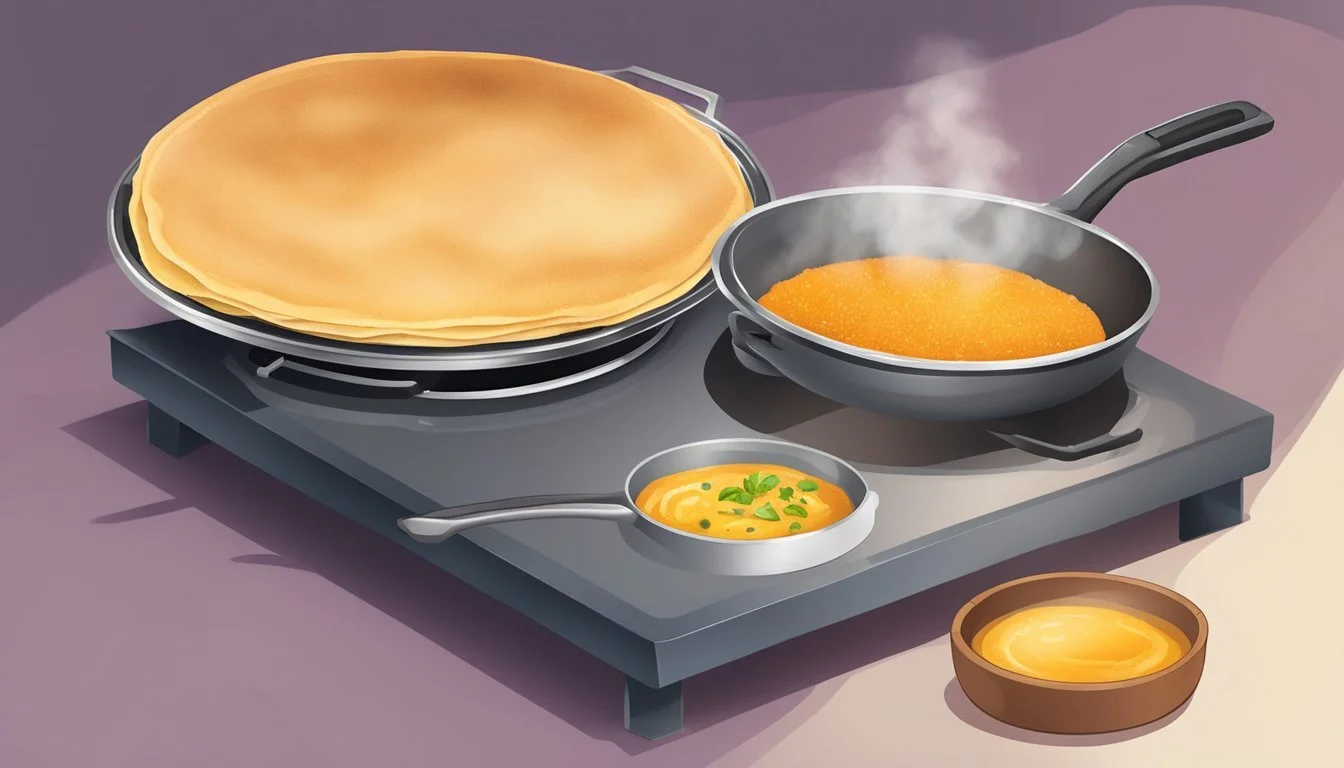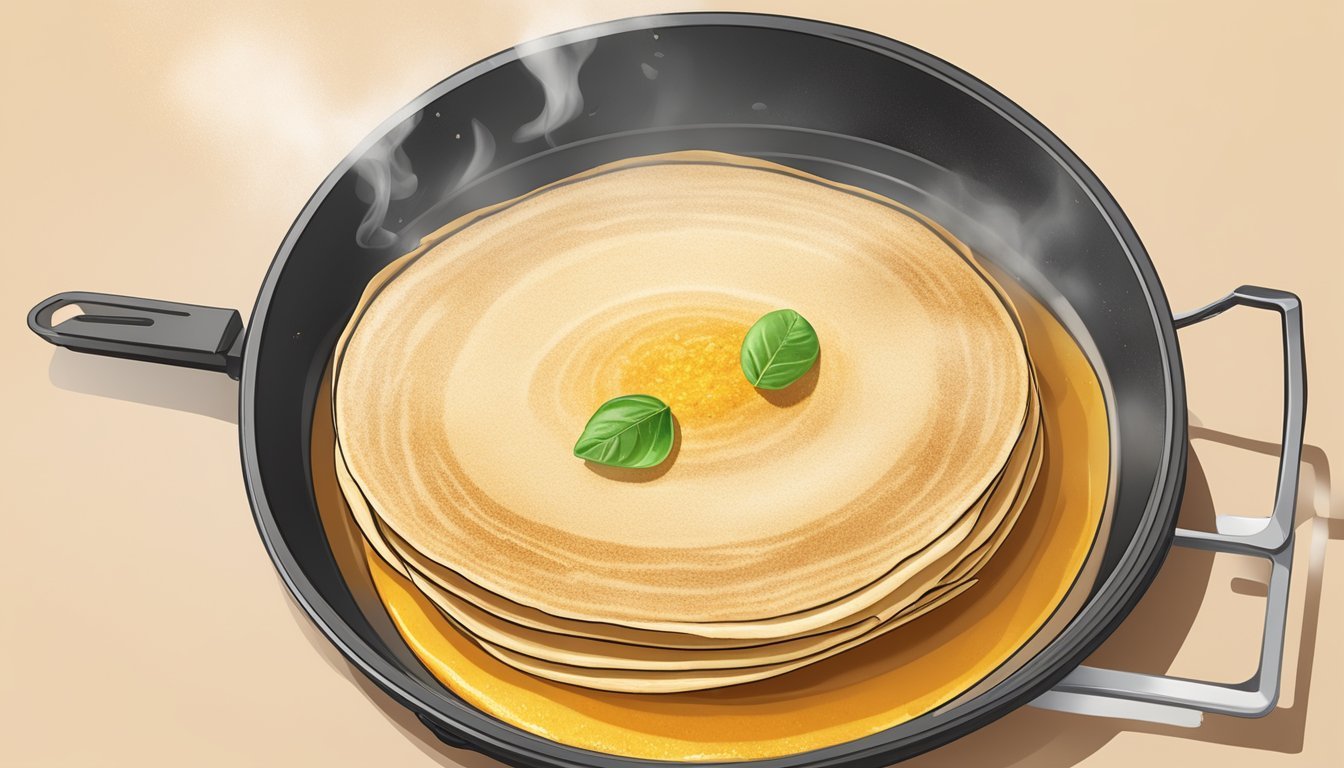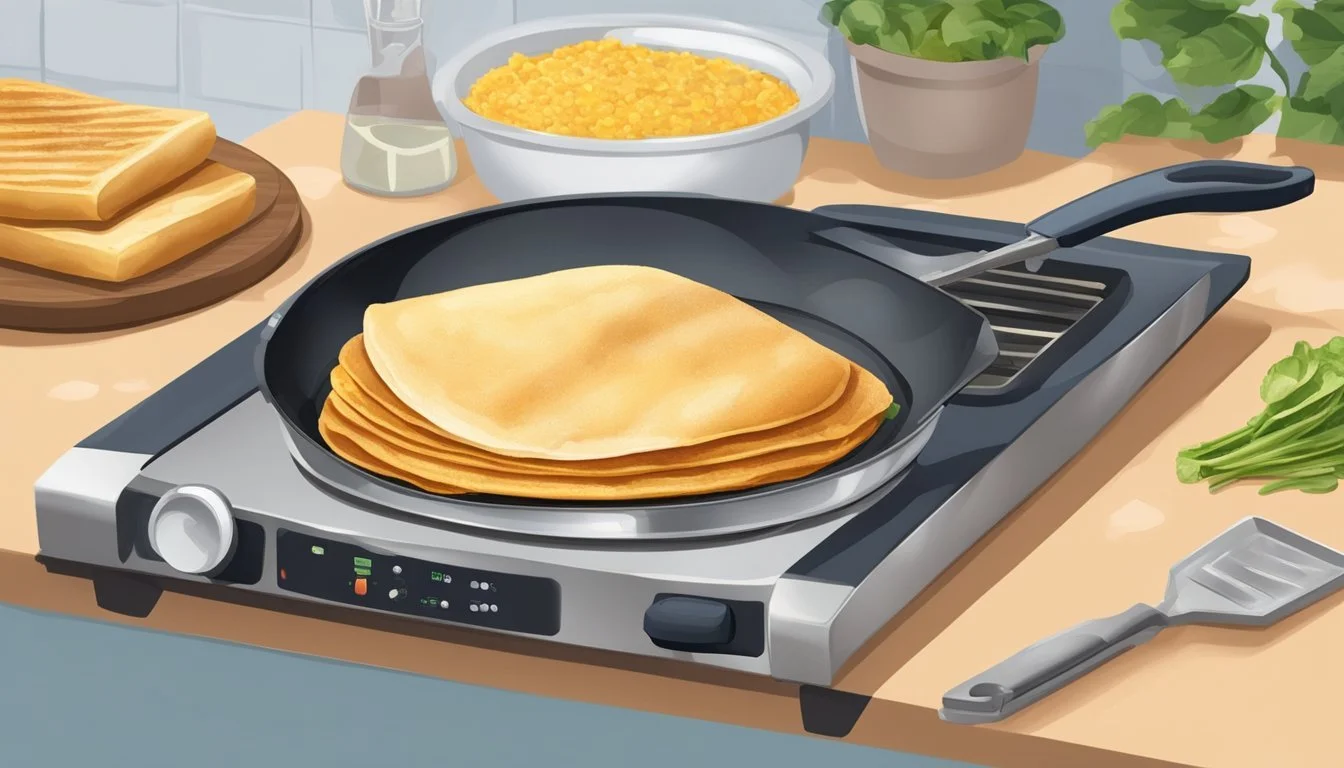Best Way to Reheat Dosa
Ensuring a Crispy Texture and Hot Filling Every Time
Dosa, a popular South Indian crepe, is known for its irresistible combination of a crispy exterior and a hot, flavorful filling. Preserving the quintessential texture and warmth of a dosa can be challenging, especially when attempting to reheat leftovers or make-ahead batches. Achieving the delicate balance of keeping the dosa crisp while ensuring the filling remains hot requires careful technique and a clear understanding of the heating methods available.
To maintain the quality of this beloved dish upon reheating, one must consider the various methods such as the use of a tawa (skillet), microwave, or conventional oven. Each method has its merits and can cater to the convenience of individuals with varying kitchen equipment and time constraints. It's crucial to navigate the reheating process in a way that emulates the fresh experience of a just-made dosa, ensuring that the dish retains its essence and appeal.
Essential Ingredients and Their Roles
In the composition of dosa, a South Indian crepe-like delicacy, essential ingredients play pivotal roles in both taste and texture.
Rice: Rice functions as the primary base, offering the necessary starches that contribute to the dosa’s crisp exterior. The type of rice selected can affect the dosa's texture, with certain varieties such as parboiled rice offering a crisper finish.
Urad Dal (Black Lentils): Urad dal is integral for fermentability and texture. It imparts a softness to the inner part of the dosa, providing a delicate contrast to the crispy outer layer.
Fenugreek Seeds: These seeds are small but mighty when it comes to influencing the dosa's aroma and flavor. They also assist in the fermentation process, promoting a good rise in the batter.
Salt: A crucial seasoning agent, salt not only enhances flavor but also plays a part in fermentation, affecting the batter's consistency and rise.
Water: The key to the batter's consistency, water must be in the correct proportion to ensure the dosa is neither too thick nor too thin. It impacts how the dosa spreads and subsequently, how it cooks.
Keep in mind, the temperature and age of these ingredients, particularly water and urad dal, can affect the fermentation process. Here’s a quick reference table to summarize their roles:
Ingredient Role in Dosa Rice Provides starch, crispiness Urad Dal Enhances fermentability, soft texture Fenugreek Seeds Aids in fermentation, adds flavor Salt Seasoning, affects fermentation Water Determines batter consistency
Each element contributes to the creation of an authentic dosa experience, playing a significant part in dosa's delectable crispiness and the warmth of the filling when reheated.
Dosa Batter Basics
The foundation of a perfect dosa lies in mastering the batter. A good dosa batter is a blend of properly selected grains and a meticulous fermentation process that gives the dosa its characteristic flavor and crispness.
Selection of Rice and Lentils
Choosing the right type of rice and lentils is essential for dosa batter. Parboiled rice or idli rice is preferred due to their starch content which contributes to crispiness. Long-grain white rice can also be used for a different flavor profile. Black gram (urad dal) is mixed with the rice to add structure and fermentability. Fenugreek seeds (methi seeds) are often included in small quantities as they help in fermentation and add flavor.
Soaking and Grinding Technique
For optimal fermentation, soak the rice, lentils, and fenugreek seeds in separate bowls for at least 6 hours or overnight. This soaking process softens the grains, making them easier to grind. Use a wet grinder for a smooth consistency; it's crucial for the batter structure. The batter should have the consistency of a thick yet pourable paste. Add water sparingly while grinding to avoid a batter that is too thin.
Fermentation Fundamentals
The fermentation process is key to a flavorful dosa batter. After grinding, transfer the batter to a large, airtight container, leaving some space for expansion. Keep the container in a warm place to encourage bacterial activity; fermentation typically takes 8 to 12 hours, depending on the ambient temperature. A well-fermented batter will have increased in volume and exhibit a slight tanginess. It’s now ready to be used for making crispy dosas.
Preparing the Dosa
To ensure a dosa’s crispness and flavor are maintained when reheated, the preparation stage is critical. This includes nailing the batter consistency, cooking techniques for a crispy result, and exploring variations for diverse tastes.
Achieving the Perfect Consistency
The consistency of dosa batter is a delicate balance between liquidity and thickness. For a crispy dosa, individuals should aim for a pourable yet not overly watery mixture. The general guideline is to use a 1:3 ratio of urad dal (split black lentils) to rice. A well-fermented batter typically has air bubbles, indicating it's light and ready to transform into a crisp dosa. When preparing the batter, add water gradually until it reaches a pourable consistency that can easily spread on a hot surface.
Making a Crispy Dosa
To achieve the coveted golden brown and crispy texture, one must heat a seasoned cast iron tawa or non-stick pan over medium heat. Lightly coat the surface with oil, preferably using a brush for even application. Pour a ladleful of batter and spread it into a thin dosa, as thinness is key for crispness. Cook the dosa until the bottom turns golden brown, ensuring the edges are crisp while the center remains slightly tender. Additionally, a paper dosa requires a larger amount of spread making it thinner, hence amplifying the crispness.
Creating Variations of Dosa
While the classic recipe calls for a rice and lentil base, one can create variations like masala dosa, rava dosa, or oats dosa by altering the ingredients. For an interesting twist, substitute semolina or mixed oats in place of rice flour for a rava dosa or oats dosa respectively, while following the same steps for preparation and cooking. Each variation requires attention to maintain the batter's consistency and the cooking process, which are the foundation for making any type of dosa crispy and enjoyable.
Masala Dosa Filling
The masala filling is a crucial element of a masala dosa, imparting flavor and texture. This section will detail how to prepare the traditional aloo masala and discuss some variations that can be explored.
Traditional Aloo Masala
The traditional aloo masala is a spiced potato filling that is both aromatic and hearty. Ingredients typically include:
Potatoes: Boiled, peeled, and mashed.
Onion: Finely chopped for a subtle crunch.
Mustard Seeds: A staple for tempering that adds a nutty flavor.
Turmeric: Gives the masala its characteristic yellow color and a warm taste.
Ginger: Freshly grated for a piquant tang.
Curry Leaves: For a distinct and savory fragrance.
To prepare, one must heat oil in a pan—typically ghee for its rich, buttery flavor—before adding the mustard seeds. Once they start to pop, add curry leaves and finely chopped onions, cooking until the onions are translucent. Next, incorporate turmeric and grated ginger, followed by the mashed potatoes. The mixture is usually seasoned with salt and sometimes a hint of lemon juice for acidity. The resulting filling should be uniformly mixed, moist, and ready to stuff inside the dosa.
Variations in Masala
Variations in the masala allow for creativity and personalization of the dosa filling. One can introduce:
Vegetables: Peas, carrots, or beans can be added to the potato mix for additional flavor and nutrition.
Cheese: A contemporary twist includes adding cheese for a gooey texture and rich taste.
Spices: Adjusting the spices, such as adding red chili powder or garam masala, caters to those preferring spicier profiles.
Each variation maintains the essence of the classic masala while offering a unique taste and texture that complements the crispy dosa shell. Whether one sticks to tradition or experiments with ingredients, the masala filling can tailor the masala dosa experience to individual preferences.
Tips for Reheating Dosa
To retain the original taste and crispiness of dosa upon reheating, the key lies in the method and tools one uses. It is paramount to control the temperature and use the right type of pan or appliance to reheat the dosa effectively.
Using a Skillet or Tawa
Temperature and Pan Selection: Heat a non-stick skillet or a cast iron tawa on medium heat. The non-stick surface or seasoned cast iron helps in retaining the crispiness of the dosa while avoiding stickiness.
Oil Application: Drizzle a few drops of oil onto the pan if necessary. It aids in even reheating and adds to the crisp quality of the dosa.
Oven Reheating Method
Preheat and Prep: Preheat the oven to a temperature of around 350°F. Use a baking sheet to avoid direct contact of dosa with the wire racks, which could affect its texture.
Reheating Duration: Place the dosa on the baking sheet and heat for a few minutes, checking frequently to ensure it does not dry out.
Microwave Reheating Suggestions
Technique: Although not ideal for crispiness, a microwave can be used if time is of the essence. Place the dosa on a microwave-safe plate and cover it with a damp paper towel to add moisture.
Time and Power: Heat in short intervals at a medium power setting to prevent the dosa from getting too tough or chewy.
Accompaniments and Side Dishes
Reheated dosas are best enjoyed with traditional South Indian accompaniments that add flavor and texture. Each side dish complements the crispy dosa and enhances the overall dining experience with its unique taste and aroma.
Sambar: The Quintessential Companion
Sambar is a flavorful lentil-based vegetable stew that is a staple in South Indian cuisine and an essential accompaniment to dosas. Prepared with a variety of vegetables, pigeon peas (toor dal), and a rich blend of spices and herbs, sambar not only offers a savory depth to the meal but also provides protein and nutrients.
Ingredients for Sambar: Toor dal, tamarind, turmeric, vegetables (such as okra, carrots, and drumsticks), sambar powder, mustard seeds, dry red chilies, curry leaves, asafetida, and coriander leaves.
Assortment of Chutneys
An array of chutneys elevates the dosa experience with their fresh, tangy, and sometimes spicy flavors. The most iconic is the coconut chutney made from grated coconut, green chilies, mustard seeds, and curry leaves, offering a creamy texture and refreshing taste. Other popular chutneys include tomato, coriander, and mint, each bringing their distinct flavors to the table.
Key Ingredients for Coconut Chutney: Fresh grated coconut, green chilies, ginger, mustard seeds, curry leaves, and urad dal.
Other Popular Pairings
Dosas can be paired with a variety of other dishes to cater to different palates. For a protein-rich option, a curried chickpea stew provides a hearty and spicy flavor profile. Additionally, dosas are often savored with idli, another South Indian staple, which when dipped in sambar or chutney, can create a satisfying breakfast or meal.
Popular Side Dishes: Curried chickpea stew, idli, potato filling, and various types of masala.
Storing and Preserving Dosa
Storing dosa correctly is crucial to maintaining its texture and flavor. Whether one opts to refrigerate for short-term convenience or freeze for extended periods, proper storage helps keep dosa tasty and ready to reheat.
Refrigeration Best Practices
For short-term storage, dosas should be placed in an airtight container or covered with aluminum foil to prevent them from drying out. It is advisable to layer them with parchment paper to prevent sticking and to use a large enough container to avoid squashing the dosas. Always ensure they have cooled down to room temperature before placing them in the refrigerator to maintain the freshness.
Cool Dosas: Wait until they reach room temperature.
Wrap Tightly: With aluminum foil or place in an airtight container.
Separate Layers: Use parchment paper between dosas.
Refrigeration Duration: Best consumed within 1-2 days for optimal taste.
Freezing Dosa for Long-Term Storage
To freeze dosas, wrap each one individually in aluminum foil, then place them inside an airtight container or heavy-duty freezer bags. This method prevents freezer burn and flavor loss, allowing the dosas to keep for up to three months.
Wrap Individually: Each dosa in aluminum foil.
Use Airtight Containers: Or heavy-duty freezer bags.
Storage Timeframe: Properly stored, dosas can be frozen for up to three months.
Retaining Freshness After Cooking
Once dosa is cooked, if they are not served immediately, one should store them correctly to retain their crispiness. Dosas should be transferred to a cooling rack to avoid sogginess from condensation and then moved to an airtight container lined with a paper towel to absorb any excess moisture.
Cool on Rack: Prevents condensation and sogginess.
Line Container: With paper towels to absorb moisture.
Store Promptly: Place in an airtight container once cooled.
Nutritional and Dietary Consideration
When reheating dosa, a popular South Indian breakfast item, it is essential to consider its nutritional content and dietary restrictions to maintain its health benefits.
Caloric and Macronutrient Breakdown
Dosa, primarily made from rice and lentils, is a vegetarian dish that provides a good balance of carbohydrates, proteins, and fats. The rice in dosa contributes to its carbohydrate content, while lentils bring in protein and fiber. Here’s a basic breakdown for a standard dosa without filling:
Calories: Approximately 120-150 per dosa
Carbohydrates: 28 grams
Proteins: 3 grams
Fats: A minimal amount, increasing if dosa is cooked with oil
These values can vary depending on the size and thickness of the dosa and the type of filling used.
Gluten-Free and Vegan Options
Dosa inherently caters to gluten-free and vegan diets, as its base ingredients include rice and lentils, both of which are free from gluten and animal products. Individuals with gluten intolerance or those following a vegan lifestyle can enjoy dosa without substantial modifications. However, one should be mindful of the fillings and accompaniments, ensuring they also meet these dietary requirements.
Dosa in South Indian Culture
Dosa, a versatile dish paramount in South Indian culture, holds a prestigious place in the region's culinary heritage. It's not just food; it's a symbol of tradition and festivity.
Breakfast Staple in South India
In South India, dosa is omnipresent as a breakfast staple. Households across the region start their day with the sizzle of this fermented rice and lentil crepe on a hot tawa. Crisp on the outside with a soft interior, the dosa is both nourishing and satiating, making it an integral part of the South Indian breakfast routine.
Dosa's Place in Indian Cuisine
Dosa has transcended its South Indian origins to become a beloved element of pan-Indian cuisine. Its simplicity allows it to be a canvas for a variety of fillings and accompaniments, from the classic potato masala to the inventive chocolate or cheese fillings found in contemporary Indian eateries. As such, it effectively represents the diversity of Indian culinary practices.
Festive Occasions and Dosa
Dosa isn't merely a daily fare; it also assumes a special role during festive occasions. In South Indian culture, specific types of dosas are often prepared during religious festivals and celebrations. Its presence on the menu signifies hospitality and joy, accompanying the elaborate feasts that mark these special days.
Advanced Techniques and Tools
To achieve the perfect reheated dosa that is both crispy and hot, one must consider the type of cookware and understand the underlying science of cooking dosa. These factors directly affect the temperature and consistency necessary for that ideal golden brown finish.
Using a Dosa Pan or Crepe Pan
A dosa pan, also known as a tawa, or a specialized crepe pan, is essential for retaining the crispness of dosa. They should use cast iron or non-stick materials for even heat distribution. When reheating, it is important to:
Preheat the pan on a medium flame to ensure the right temperature.
Place the dosa on the pan for a short duration on each side until it reaches a golden brown color.
This technique ensures that the dosa is not only warm but also retains its characteristic crispiness.
The Science of Cooking Dosa
Understanding the fermentation process of the dosa batter is crucial. Fermentation imparts the unique flavor and texture to dosa, and upon reheating, one aims to preserve these qualities. To do so, they need to consider:
Using a wet grinder for batter produces a consistent and fine consistency, facilitating even cooking.
Maintaining a moderate temperature while reheating to avoid overcooking the edges, while ensuring the filling is hot.
This approach applies scientific principles to maintain the dosa's quality during reheating, ensuring optimal taste and texture.
Final Recommendations
The key to reheating dosa lies in maintaining its crispness while ensuring the filling remains hot. Below are specific strategies and solutions to common reheating challenges.
Dos and Don'ts
Do:
Use a preheated tawa or skillet on medium heat to restore the dosa's crispiness.
If a microwave is the only option, wrap the dosa in a damp paper towel to prevent dryness.
Apply a thin layer of oil to the tawa before reheating to enhance flavor and crispness.
Don't:
Overheat, as this can make the dosa hard and lose its characteristic texture.
Reheat dosa in a microwave without a damp paper towel, as it can make them soggy.
Use high temperatures on a skillet or in the oven, which could burn the dosa rather than crisping it.
Troubleshooting Common Issues
Batter Consistency: If the dosa lacks crispness after reheating, check the batter consistency. It should not be too runny nor too thick.
Temperature Control: Reheat dosas on moderate heat. Excessive heat can cause them to become tough rather than crispy.
Fermentation: Proper fermentation is crucial. Under-fermented batter may result in dosas that do not reheat well.
Crispiness: If dosas aren’t becoming crispy, placing them in a preheated oven for a few minutes can help, but monitor closely to prevent drying out.






